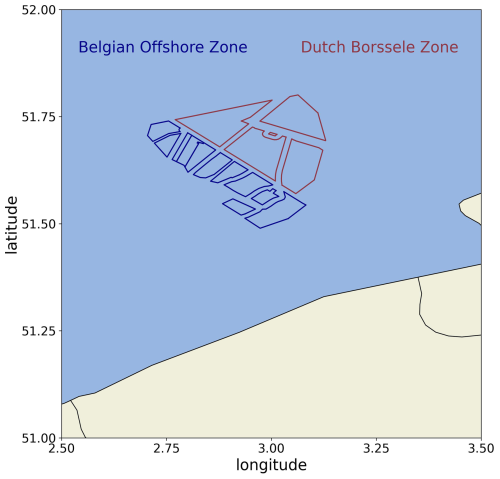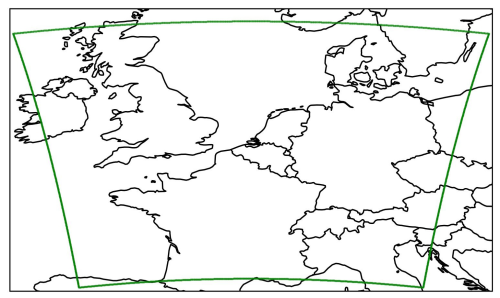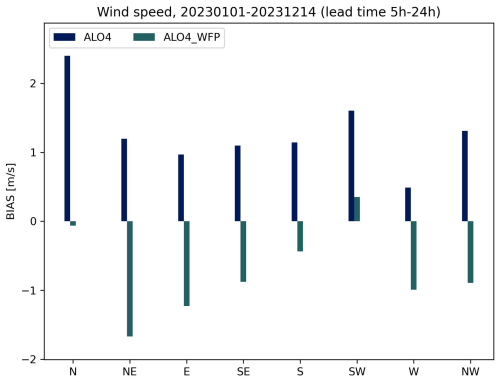Improving wind power forecasts in the Belgian North Sea with a wind farm parameterization and a neural network
Dieter Van den Bleeken
Joris Van den Bergh
Idir Dehmous
Daan Degrauwe
Michiel Van Ginderachter
Alex Deckmyn
In order to forecast the impact of meteorological events, such as large wind storms, on the Belgian offshore wind energy production and mitigate its impact on the high-voltage electricity grid, the Royal Meteorological Institute of Belgium (RMI) has in the past developed a dedicated storm forecast tool for Elia, the Belgian transmission system operator (TSO). The storm forecast tool, which has been operational since November 2018, provides 15 min wind speed and wind power forecasts for each wind farm in the Belgian offshore wind energy zone (BOZ), together with cut-out probabilities and uncertainty quantification, by combining the RMI high-resolution (4 km) ALARO model with the ENS ensemble forecasts of the European Centre for Medium Range Weather Forecasting (ECMWF).
Since the completion of the first Belgian offshore wind energy zone in 2020, for an installed capacity of 2.26 GW, a significant amount of wind energy is now available in the Belgian part of the North Sea. There are considerable wake losses in the BOZ, as all wind farms lie close together in a narrow band, and each wind farm has a high density, in terms of number of turbines, and/or installed power per area. Moreover, the adjacent Dutch Borssele Wind Farm Zone, completed in 2021, can also significantly influence the BOZ (and vice versa).
We report on two approaches to improve RMI's offshore wind power forecasts, and in particular to take into account wake losses. First the Fitch et al. wind farm parameterization (WFP) was implemented in the ALARO model, based on an earlier implementation by KNMI into HARMONIE-AROME. Both these models are being developed in the ACCORD consortium, and use the same dynamical core to some extent, with IFS/ARPEGE global codes as basis, but differ greatly in the different physics parameterizations used, and the physics-dynamics coupling (tendencies vs fluxes). Secondly, we investigated using an artificial neural network trained on Elia wind power production data and NWP forecasts. Verification of the improved wind and power forecasts is based on lidar data at an anonymous wind farm, and power data from Elia. Each method is found to improve forecast accuracy and able to capture certain wake effects in the BOZ. A combination of both methods gives the best results on average, and leads to competitive forecast scores.
- Article
(5706 KB) - Full-text XML
- BibTeX
- EndNote
Since the end of 2020, eight offshore wind farms (or nine zones) are operational in the Belgian Offshore wind energy Zone (BOZ), with a total capacity of 2.26 GW. Together, these produce approximately 8 TWh of electricity annually, see e.g. the Belgian Offshore Platform website (BOP, 2025). All wind farms lie close together in a narrow band in the Belgian part of the North Sea, adjacent to the Dutch Borssele wind farm zone that became fully operational in 2021, see Fig. 1.
Using the operational high-resolution (4 km) ALARO model, the Royal Meteorological Institute of Belgium (RMI) makes custom 15 min wind speed and wind power forecasts for each wind farm in the BOZ. These are then combined with ENS ensemble forecasts of the European Centre for Medium Range Weather Forecasting (ECMWF), to deliver probabilistic power forecasts and storm cut-out alerts to Elia, the Belgian TSO, as part of an operational “Storm Forecast Tool” (Smet et al., 2019). In this product, the ALARO forecast is added to the ENS ensemble as extra members with a certain weight that minimizes CRPS, with ALARO typically being worth 15 to 7 ENS members, depending on the lead time.
To improve RMI's offshore wind energy forecasts, and in particular to be able to take into account the considerable wake effects in the BOZ, we have investigated both the implementation of a wind farm parameterization in the ALARO model, and using an artificial neural network trained on power observations. Each method can be used separately, but both can also be combined by training the neural network on the output of the ALARO model with wind farm parameterization. This paper is organized as follows: In Sect. 2 we discuss some relevant aspects of the wind farm parametrization as used in this work. Section 3 shortly describes the neural network and its training setup and in Sect. 4 we give an overview of the different types of wind power forecasts that were studied. In Sect. 5 the various forecasts are compared through validation against observations and the results are discussed. Finally, Sect. 6 contains a short summary, with conclusions and outlook.
For a systematic literature review on WFP implementations in mesoscale NWP models, we refer to Fischereit et al. (2022). Our approach is based on the HARMONIE-AROME implementation (van Stratum et al., 2022) of the Fitch (Fitch et al., 2012) wind farm parameterization (WFP). Conceptually this WFP represents wind turbines as a sink of momentum and source of turbulent kinetic energy (TKE). More precisely the tendencies of horizontal wind () and TKE are set by the formula
where ρ is the air density, M the mass of the parcel considered, Arotor the area spanned by the rotor blades and CT, CP respectively the thrust and power coefficients of the turbine. In the NWP model the above is discretized over both horizontal gridpoints and vertical levels, with contributions only for gridboxes where turbines are present (multiple contributions are summed) and only for vertical levels that overlap with the rotor blades (weighted by the fraction of Arotor covered.)
The ALARO model (Termonia et al., 2018) differs from HARMONIE-AROME used in (van Stratum et al., 2022) in several ways. The boundary layer is modeled using the TOUCANS scheme (Ďurán et al., 2014) while the parametrization of microphysical processes is similar to those as described in (Lopez, 2002). Unlike HARMONIE-AROME (and AROME), the ALARO model also still has an explicit deep convection scheme (3MT) designed to work at multiple resolutions from 10 km to a few hundred meter, as first described in (Gerard et al., 2009). Furthermore, ALARO differs from HARMONIE-AROME in two ways relevant to the WFP. First of all the turbulence scheme of ALARO (Ďurán et al., 2018) includes two prognostic energy variables. In addition to TKE there is also total turbulent energy (TTE), which is the sum of TKE and turbulent potential energy (TPE). This TPE is that part of potential energy that can be converted into TKE and is proportional to the square of temperature fluctuations (Zilitinkevich et al., 2013). The turbines are considered not to alter TPE and thus, the change in TTE is equivalent to the change in TKE here, i.e. with the right side determined by (2). Secondly, ALARO internally represents changes of prognostic variables through fluxes rather than tendencies. The former are integrals over the vertical direction of the latter, e.g. the flux φV of horizontal wind velocity is related to its tendency as
Here we have expressed the formula in terms of an integral over geopotential z, with ztop being its value at the top of the atmosphere, where the flux φV generated by the turbines vanishes. The ALARO WFP works as follows: a call is made to the WFP routine of van Stratum et al. (2022) to obtain the contribution to the tendencies of V and TKE by all turbines, the turbine contribution to V tendency is transformed into a contribution to V flux via (3), after which the WFP contributions and φV are added to the contributions of other physics parameterizations. The forward step of the model will then use these to compute updated values for all variables at the next time step.
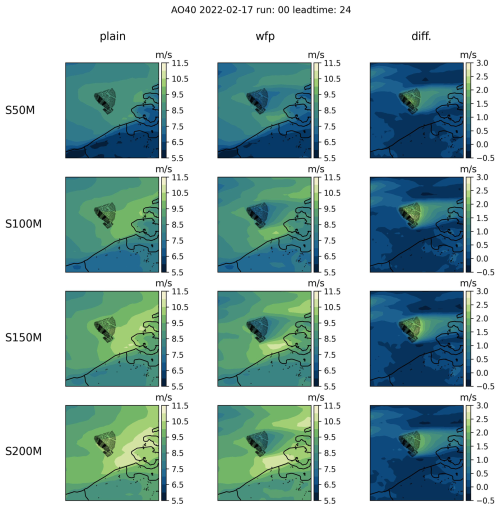
Figure 3ALARO 4 km runs with WFP switched off (left), switched on (middle), and difference (right) between the two runs, initialized on 17 February 2022 at 00:00 UTC, for lead time +24 h, with from top to bottom showing 50, 100, 150 and 200 m wind speed.
The ALARO model runs (at 4 km resolution) were performed over a domain that includes a large part of Europe, spanning roughly from the north of the United Kingdom to the south of France and the west of Ireland to the east of Germany, see Fig. 2. The turbine characteristics and locations originate from a static private database that covers the best knowledge of these over the whole domain as they were at the end of 2022. Only those turbines in or close to the BOZ are effectively relevant for the study presented here, their relative locations can be seen in Fig. 3 and some of their properties, such as hub height and nominal power can be found on (BOP, 2025). Both the BOZ and Borssele wind farms were already fully operational during the entire period of this study (2022 and 2023). Other wind farms in the North Sea were still being build during this period. For instance the construction of the Dutch wind farms Hollandse Kust Zuid and Noord was ongoing in 2022 and 2023, both being fully operational only at the end of September 2023 and December 2023, respectively. However, giving the distance of these wind farms to the BOZ, we believe the use of a static wind turbine database shouldn't have too much impact on our results.
A forecast example from two identical ALARO runs with the WFP implemented, and either switched off/on, and their difference is shown in Fig. 3. Significant wake effects are visible, showing that both the WFP is functioning, and that wind speed differences due to wake effects can indeed be quite significant in the BOZ. Further validation results will be shown in Sect. 5.
Since RMI has a multi-year database of wind power production data and ALARO 4 km wind forecasts a data-driven approach where wind speed is converted to power by a machine learning model presented itself. Given the limited number of parameters in the problem it was decided to consider a model as simple as possible and to investigate if even such minimal models, trainable in a few minutes on a laptop, can already have significant impact. A Neural Network architecture was selected that takes as input NWP forecast model wind speed, wind direction and lead time, and that is trained to produce the corresponding wind power. Wind direction is included in the input to allow the model to learn about wake effects (Barthelmie et al., 2009; Platis et al., 2018) while lead time allows it to take into account time of day effects (we consider only forecasts initialized at 00:00 UTC in this paper) as well as biases that can depend on the number of steps in the forecast.
More precisely, the network is a multi-layer perceptron (Almeida, 2020) with a 3 node input layer and single node output layer. After exploring a few different settings an optimal configuration of three intermediate layers of each 64 nodes was selected in combination with mean absolute error (MAE) as training loss, using stochastic gradient descent with Adam optimizer, and early stopping. We refer to this neural network architecture as the Neural Power Net (NPN). The NPN is separately trained for each wind farm in the BOZ on one year of training data (2022), consisting of 15 min ALARO wind speed and wind direction forecasts, and Elia wind power production data. Further validation is then performed on the 2023 test data. The 2022 training data was randomly split in 15 % for hyperparameter tuning and 85 % for NPN weight optimization.
In RMI's operational Elia Storm Forecast Tool, wind speed predictions by the ALARO NWP model at 4 km horizontal resolution (ALO4) are currently converted to wind power using power coefficient CP curves:
and are then for some undisclosable wind farms further corrected using quantile regression (and historical power production data). We will refer to these operational power forecasts as ALO4_CP, and take them as benchmark. Three different ways to improve these forecasts have been investigated.
The first consist of adding a WFP to the ALARO NWP model to allow it to capture wake effects and enhance its wind speed prediction skill. Then converting this corrected wind speed to wind power using power coefficient curves amounts to a power forecasting model we refer to as ALO4_WFP_CP. No further quantile regression corrections are applied here.
A second model, ALO4_NPN, uses the original ALO4 wind speed forecasts but converts them to power using NPN (trained on ALO4 wind speed and wind direction data).
Finally, the third configuration is a combination of the first and second, where NPN is trained on ALO4_WFP wind forecasts and then used to convert such ALARO with WFP wind forecasts into power. We call this model ALO4_WFP_NPN.
Since ALO4_WFP forecast data was available from 1 June 2021 until 31 May 2024, we decided to train the ALO4_NPN and ALO4_WFP_NPN on the full year of 2022, and produce forecasts for the year 2023. All models are therefore compared in the next section for the year 2023, in fact between 1 January and 14 December 2023, due to some missing power production data. We only consider forecasts initialized at 00:00 UTC in this work, and for a lead time up to 60 h.
5.1 Wind speed
Wind speed forecasts at turbine height from ALO4 and ALO4_WFP were evaluated against lidar data from an anonymous wind farm, with BIAS and RMSE shown in Fig. 4. A clear benefit of the WFP is seen in terms of RMSE, but with a negative BIAS of 0.5 m s−1, while the model without WFP has a positive BIAS of more than 1 m s−1. It's possible the WFP has too strong wakes in certain cases, leading to an underestimation of the wind speed on average. However, the lidar might also not see the full influence of wake effects depending on the wind direction, due to its location, inside the wind farm (at the offshore high voltage station). We indeed see significant differences in BIAS, when splitting the results per wind direction, especially pronounced for ALO4_WFP, see Fig. 5. These wake effects could be further investigated using turbine SCADA data, but this is outside the scope of the current study.
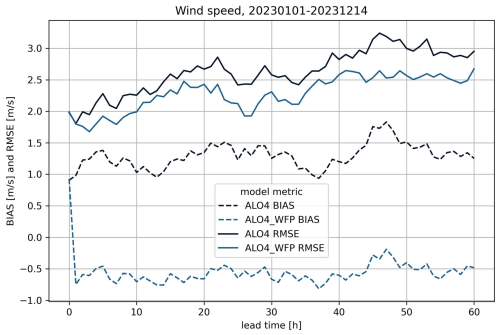
Figure 4BIAS and RMSE of turbine height wind speed forecasts for ALO4 and ALO4_WFP, evaluated against lidar data from an anonymous wind farm in the BOZ, averaged over the period 1 January–14 December 2023.
5.2 Wind power
Power forecasts aggregated for the BOZ, from ALO4_CP, ALO4_WFP, ALO4_NPN and ALO4_WFP_NPN and evaluated against 15 min power production data from Elia are shown in Fig. 6. One observes that each of the three new approaches improve upon the currently operational forecasts. Using NPN to improve wind to power conversions seems to outperform improving wind forecasts using a WFP but keeping power curved based conversion. The most skilled model is however the combination of the WFP improved wind forecasts with NPN based wind to power conversion.
Averaging the results over all lead times but splitting them up per wind direction (from the model forecasts), see Fig. 7, reveals that NPN manages to incorporate wake effects through the wind to power conversion. This is most notable in the wind directions SE and NW, where there is a large difference between ALO4 and ALO4_WFP. The fact that WFP+NPN outperforms NPN on its own shows however that the neural net benefits from taking wake corrected wind forecasts as input, and needs further investigation. Also note in Fig. 7 the relatively small wake effects in the SW direction, which is the most dominant wind direction, and a consequence of the BOZ design. Another curious feature seen in Fig. 7 is the worse performance of ALO4_WFP compared to ALO4 when wind comes from the North, which might be related to the nearby Borssele Wind Farm Zone and also deserves to be looked into further.
Our approach to machine learning (ML) wind power forecasting at farm level differs from another recently proposed modular deep learning method (Ally et al., 2025) applied to the BOZ, in at least two ways. First, we take as input NWP forecasts (not SCADA data) to train the ML power model and thus also automatically correct (at least partly) for NWP forecast deficiencies. Two, we also consider as input NWP models with a wind farm parameterization, which is not yet widely available as operational forecast product, and thus also take into account influence of nearby wind farms, e.g. wake effects, blockage, etc., at the mesoscale resolution of the NWP model. Note that the MAE scores of the NPN models in Fig. 6 are competitive with the 9 % MAE and 9.4 % MAE mentioned in figure 36 of (Ally et al., 2025) for intraday (up to 12 h lead time) and day-ahead (up to 36 h lead time), respectively.
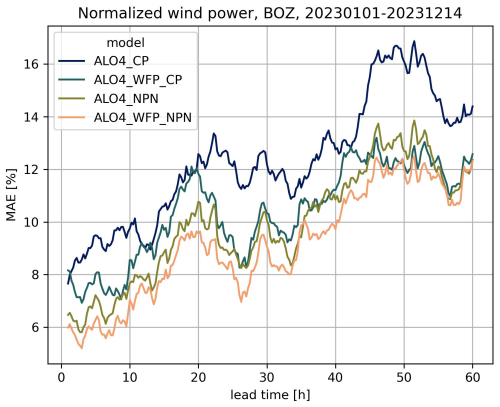
Figure 6MAE of wind power forecasts for ALO4_CP, ALO4_WFP_CP, ALO4_NPN and ALO4_WFP_NPN, as a percentage of installed capacity, verified against wind power production data aggregated at BOZ level, and averaged over the period 1 January–14 December 2023.
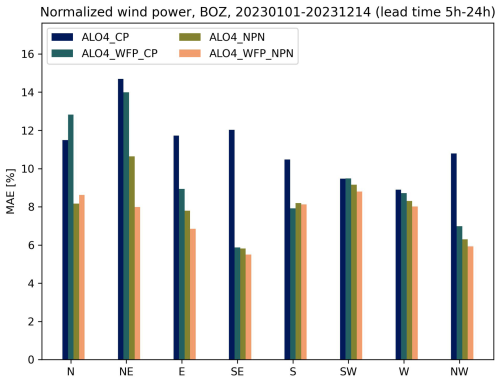
Figure 7MAE of wind power forecasts for ALO4_CP, ALO4_WFP_CP, ALO4_NPN and ALO4_WFP_NPN, as a percentage of installed capacity, verified against wind power production data aggregated at BOZ level, and averaged over the period 1 January–14 December 2023, split per wind direction (all forecast lead times from 5 up to 24 h).
5.3 Storm Ciarán
A downside of the neural networks trained to optimize MAE, seems to be a worse performance during extreme events, in particular cut-out events due to large wind storms, which are particularly interesting for the Belgian TSO. An example is shown in Fig. 8 for wind power forecasts at BOZ level during storm Ciarán in November 2023. This was a case where all wind farms in the BOZ shut down for some time, and ALO4_CP and ALO4_WFP_CP forecasted this cut-out relatively well, albeit with some timing error(s), while the neural network forecasts ALO4_NPN and ALO4_WFP_NPN continued to forecast close to maximum production. This may be due to the relatively few storms in the 2022 training data, although several large storms like Eunice were still present, and/or due to the fact that false alarms or timing errors of extreme events can lead to large (and double) penalties in terms of MAE, thereby favoring more smoothed forecasts. While a simple solution would be to use ALO4_CP or ALO4_WFP_CP when forecasted wind speeds are above a certain threshold, other solutions are under investigation as well. These include oversampling of cut-out events, use of loss functions that give more weight to cut-out events, and use of advanced ML-based techniques such as extreme gradient boosting (Chen and Guestrin, 2016) and temporal fusion transformers (Lim et al., 2021).
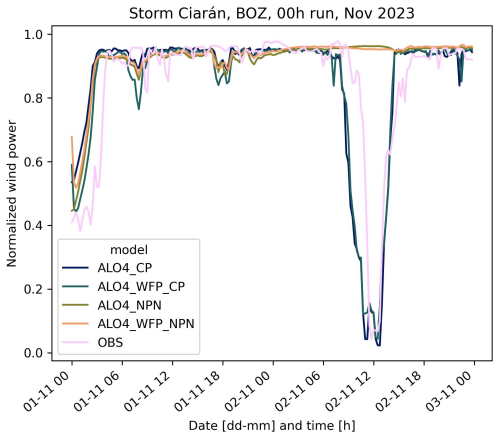
Figure 8Time series of wind power forecasts for ALO4_CP, ALO4_WFP_CP, ALO4_NPN and ALO4_WFP_NPN, for the period 1 November–2 November 2023, during storm Ciarán.
To forecast events such as large wind power ramps and cut-outs adequately, a probabilistic approach may be necessary, with conversion to power performed with ML-based ensemble postprocessing methods (Worsnop et al., 2018; Muschinski et al., 2022; Bouallègue et al., 2024; Van Poecke et al., 2024).
We implemented a WFP in RMI's ALARO model, to take into account wake effects in the densely build BOZ. To further improve wind power forecasts, we also trained an artificial neural network, called NPN, giving NWP forecasts as input and trained on power data from Elia. It was shown that both the WFP and NPN are able to capture certain wake effects in the BOZ and improve forecast accuracy. Curiously, giving NPN data from the NWP with WFP still leads to a further improvement in forecast scores. Combining both methods thus gives the best results (on average), and leads to competitive power forecast scores.
The method(s) should be extendable to other offshore clusters. In particular the NPN models show that significant improvement in forecast scores can be attained when enough power data to train is available, and that the impact of wake effects can be included this way, even if they are not yet taken into account in the (NWP) input data. Having NWP with WFP as input data can still give extra benefits however, and can also be useful to investigate wake impacts of nearby future offshore zones being build, such as the planned Princess Elisabeth Zone (PEZ) (Porchetta et al., 2024; Borgers et al., 2025), Belgium's second offshore wind zone.
A downside of the current NPN models, is their tendency to miss extreme events, like cut-outs due to high wind speeds, or produce too smooth forecasts in these cases. Possible solutions are under investigation, as discussed in the previous section.
In a next step, we intend to implement the best power conversion method (which should give both accurate power forecasts as well as capture cut-out events) in combination with ALARO WFP into the operational RMI Storm Forecast Tool.
Further improving accuracy of high-impact events such as wind power ramping (Gallego-Castillo et al., 2015), in addition to cut-out events, is another future priority, as the impact on the Belgian electricity grid of ramping events due to offshore wind will increase significantly when the PEZ is being developed (currently planned for 2028–2030).
Finally, work is also ongoing to include the ALARO WFP implementation in the latest code cycles of the ACCORD NWP consortium (previously ALADIN and HIRLAM), and into the operational workflow of the Destination Earth On-Demand Extremes Digital Twin.
The wind forecasts at wind farm level and power forecasts at BOZ level are available under certain conditions by contacting the corresponding author. Power production data at BOZ level with 15 min temporal resolution is available on the Elia website (https://opendata.elia.be/explore/dataset/ods031/information/, last access: 15 October 2025). Hourly power production data per wind farm in the BOZ can be found on the ENTSO-E Transparency Platform (https://transparency.entsoe.eu/, last access: 15 October 2025).
DVdB: conceptualisation, methodology, investigation, software, writing, ALO4_WFP implementation and runs. GS: conceptualisation, methodology, investigation, data acquisition, writing, ALO4_WFP implementation. JVdB: conceptualisation, methodology, investigation, writing. ID: ALO4_WFP implementation and runs. DD, MVG, AD: ALO4_WFP implementation.
The contact author has declared that none of the authors has any competing interests.
Publisher’s note: Copernicus Publications remains neutral with regard to jurisdictional claims made in the text, published maps, institutional affiliations, or any other geographical representation in this paper. While Copernicus Publications makes every effort to include appropriate place names, the final responsibility lies with the authors. Views expressed in the text are those of the authors and do not necessarily reflect the views of the publisher.
This article is part of the special issue “EMS Annual Meeting: European Conference for Applied Meteorology and Climatology 2024”. It is a result of the EMS Annual Meeting 2024, Barcelona, Spain, 2–6 September 2024. The corresponding presentation was part of session OSA2.1: Energy Meteorology.
We would like to thank Natalie Theeuwes for information on the KNMI implementation of a WFP in HARMONIE-AROME, and Mario Hrastinski and Martina Tudor for very useful comments on an earlier version of our ALARO WFP implementation. The Scientific colour maps (Crameri, 2018) are used in this study to prevent visual distortion of the data and exclusion of readers with colour-vision deficiencies (Crameri et al., 2020).
This research has been supported by the Energy Transition Fund of the Belgian federal government through the BeFORECAST project (https://beforecast.eu/, last access: 15 October 2025).
This paper was edited by Ekaterina Batchvarova and reviewed by two anonymous referees.
Ally, S., Verstraeten, T., Daems, P.-J., Nowé, A., and Helsen, J.: Modular deep learning approach for wind farm power forecasting and wake loss prediction, Wind Energ. Sci., 10, 779–812, https://doi.org/10.5194/wes-10-779-2025, 2025. a, b
Almeida, L. B.: Multilayer perceptrons, in: Handbook of Neural Computation, pp. C1–2, CRC Press, https://doi.org/10.1201/9780429142772, 2020. a
Barthelmie, R. J., Hansen, K., Frandsen, S. T., Rathmann, O., Schepers, J., Schlez, W., Phillips, J., Rados, K., Zervos, A., Politis, E., et al.: Modelling and measuring flow and wind turbine wakes in large wind farms offshore, Wind Energy: An International Journal for Progress and Applications in Wind Power Conversion Technology, 12, 431–444, 2009. a
BOP: Belgian Offshore Platform website, https://www.belgianoffshoreplatform.be/en/, last access: 2 June 2025. a, b
Borgers, R., van Lipzig, N. P. M., and Meyers, J.: Energy production and inter-farm wake losses in future North Sea wind farms, Environmental Research Letters, https://doi.org/10.1088/1748-9326/add8a2, 2025. a
Bouallègue, Z. B., Weyn, J. A., Clare, M. C., Dramsch, J., Dueben, P., and Chantry, M.: Improving medium-range ensemble weather forecasts with hierarchical ensemble transformers, Artificial Intelligence for the Earth Systems, 3, e230027, https://doi.org/10.1175/AIES-D-23-0027.1, 2024. a
Chen, T. and Guestrin, C.: Xgboost: A scalable tree boosting system, in: Proceedings of the 22nd acm sigkdd international conference on knowledge discovery and data mining, 785–794, https://doi.org/10.1145/2939672.2939785, 2016. a
Crameri, F.: Scientific colour maps, Zenodo [data set], https://doi.org/10.5281/zenodo.1243862, 2018. a
Crameri, F., Shephard, G. E., and Heron, P. J.: The misuse of colour in science communication, Nature Communications, 11, 5444, https://doi.org/10.1038/s41467-020-19160-7, 2020. a
Ďurán, I. B., Geleyn, J.-F., and Váňa, F.: A compact model for the stability dependency of TKE production–destruction–conversion terms valid for the whole range of Richardson numbers, Journal of the Atmospheric Sciences, 71, 3004–3026, 2014. a
Ďurán, I. B., Geleyn, J.-F., Váňa, F., Schmidli, J., and Brožková, R.: A Turbulence Scheme with Two Prognostic Turbulence Energies, Journal of the Atmospheric Sciences, 75, 3381–3402, 2018. a
Fischereit, J., Brown, R., Larsén, X. G., Badger, J., and Hawkes, G.: Review of mesoscale wind-farm parametrizations and their applications, Boundary-Layer Meteorology, 182, 175–224, 2022. a
Fitch, A. C., Olson, J. B., Lundquist, J. K., Dudhia, J., Gupta, A. K., Michalakes, J., and Barstad, I.: Local and mesoscale impacts of wind farms as parameterized in a mesoscale NWP model, Monthly Weather Review, 140, 3017–3038, 2012. a
Gallego-Castillo, C., Cuerva-Tejero, A., and Lopez-Garcia, O.: A review on the recent history of wind power ramp forecasting, Renewable and Sustainable Energy Reviews, 52, 1148–1157, https://doi.org/10.1016/j.rser.2015.07.154, 2015. a
Gerard, L., Piriou, J.-M., Brožková, R., Geleyn, J.-F., and Banciu, D.: Cloud and Precipitation Parameterization in a Meso-Gamma-Scale Operational Weather Prediction Model, Monthly Weather Review, 137, 3960–3977, https://doi.org/10.1175/2009MWR2750.1, 2009. a
Lim, B., Arık, S. Ö., Loeff, N., and Pfister, T.: Temporal fusion transformers for interpretable multi-horizon time series forecasting, International Journal of Forecasting, 37, 1748–1764, 2021. a
Lopez, P.: Implementation and validation of a new prognostic large-scale cloud and precipitation scheme for climate and data-assimilation purposes, Quarterly Journal of the Royal Meteorological Society: A journal of the atmospheric sciences, applied meteorology and physical oceanography, 128, 229–257, 2002. a
Muschinski, T., Lang, M. N., Mayr, G. J., Messner, J. W., Zeileis, A., and Simon, T.: Predicting power ramps from joint distributions of future wind speeds, Wind Energ. Sci., 7, 2393–2405, https://doi.org/10.5194/wes-7-2393-2022, 2022. a
Platis, A., Siedersleben, S. K., Bange, J., Lampert, A., Bärfuss, K., Hankers, R., Cañadillas, B., Foreman, R., Schulz-Stellenfleth, J., Djath, B., et al.: First in situ evidence of wakes in the far field behind offshore wind farms, Scientific reports, 8, 2163, https://doi.org/10.1038/s41598-018-20389-y, 2018. a
Porchetta, S., Howland, M. F., Borgers, R., Buckingham, S., and Munters, W.: Annual wake impacts in and between wind farm clusters modelled by a mesoscale numerical weather prediction model and fast-running engineering models, Wind Energ. Sci. Discuss. [preprint], https://doi.org/10.5194/wes-2024-58, in review, 2024. a
Smet, G., Van den Bergh, J., and Termonia, P.: Probabilistic storm forecasts for wind farms in the North Sea, Joint ALADIN-HIRLAM Newsletter No. 12, January, 17–24, https://www.umr-cnrm.fr/aladin/IMG/pdf/nl12.pdf (last access: 14 October 2025), 2019. a
Termonia, P., Fischer, C., Bazile, E., Bouyssel, F., Brožková, R., Bénard, P., Bochenek, B., Degrauwe, D., Derková, M., El Khatib, R., Hamdi, R., Mašek, J., Pottier, P., Pristov, N., Seity, Y., Smolíková, P., Španiel, O., Tudor, M., Wang, Y., Wittmann, C., and Joly, A.: The ALADIN System and its canonical model configurations AROME CY41T1 and ALARO CY40T1, Geosci. Model Dev., 11, 257–281, https://doi.org/10.5194/gmd-11-257-2018, 2018. a
Van Poecke, A., Finn, T. S., Meng, R., Bergh, J. V. d., Smet, G., Demaeyer, J., Termonia, P., Tabari, H., and Hellinckx, P.: Self-attentive Transformer for Fast and Accurate Postprocessing of Temperature and Wind Speed Forecasts, arXiv [preprint], https://doi.org/10.48550/arXiv.2412.13957, 2024. a
van Stratum, B., Theeuwes, N., Barkmeijer, J., van Ulft, B., and Wijnant, I.: A One-Year-Long Evaluation of a Wind-Farm Parameterization in HARMONIE-AROME, Journal of Advances in Modeling Earth Systems, 14, e2021MS002947, https://doi.org/10.1029/2021MS002947, 2022. a, b, c
Worsnop, R. P., Scheuerer, M., Hamill, T. M., and Lundquist, J. K.: Generating wind power scenarios for probabilistic ramp event prediction using multivariate statistical post-processing, Wind Energ. Sci., 3, 371–393, https://doi.org/10.5194/wes-3-371-2018, 2018. a
Zilitinkevich, S., Elperin, T., Kleeorin, N., Rogachevskii, I., and Esau, I.: A hierarchy of energy-and flux-budget (EFB) turbulence closure models for stably-stratified geophysical flows, Boundary-Layer Meteorology, 146, 341–373, 2013. a
- Abstract
- Introduction
- Wind farm parameterization
- Neural network for wind to power conversion
- Forecast data
- Validation results and discussions
- Conclusions and outlook
- Data availability
- Author contributions
- Competing interests
- Disclaimer
- Special issue statement
- Acknowledgements
- Financial support
- Review statement
- References
- Abstract
- Introduction
- Wind farm parameterization
- Neural network for wind to power conversion
- Forecast data
- Validation results and discussions
- Conclusions and outlook
- Data availability
- Author contributions
- Competing interests
- Disclaimer
- Special issue statement
- Acknowledgements
- Financial support
- Review statement
- References





